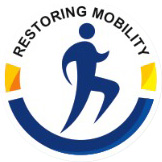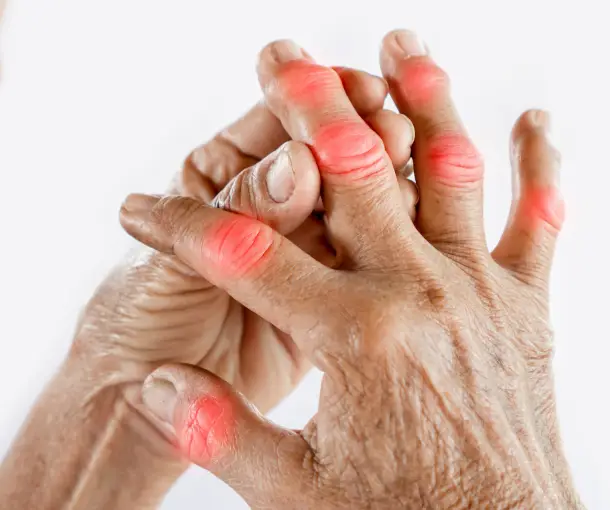Arthritis
What is arthritis?
The term “arthritis” refers to inflammation of one or more joints in the body. A joint is an area where two or more bones make contact and move against each other. The underlying cause differs depending on the kind of arthritis. There are about 100 different types of arthritis, the most prevalent of which being osteoarthritis and rheumatoid arthritis.
Osteoarthritis, commonly known as degenerative joint disease, is caused in part by cartilage deterioration in the joints and worsens with age. Reactive inflammation may occur as a consequence of increased wear and degradation on components of the affected joint. In contrast, rheumatoid arthritis (RA) is an autoimmune illness in which the body’s own defenses attack the natural joint lining. Inflammation in the joint lining and inside the bones causes joint destruction, particularly to the cartilage, in this kind of arthritis. Injuries, incorrect limb alignment, infections, autoimmune disorders other than rheumatoid arthritis, and aberrant deposits in the joints, such as in gout, are all relatively frequent causes of arthritis.
What are the different types of arthritis?
Arthritis is classified into numerous categories. Typical examples include:
– Ankylosing Spondylitis is a type of arthritis that mostly affects the spine. It is often characterized by redness, heat, swelling, and discomfort in the spine or at the joint where the bottom of the spine joins the pelvic bone.
– Gout is caused by the accumulation of crystals in the joints. It commonly affects the toe, but it may affect many other joints as well.
– The phrase “juvenile arthritis” refers to arthritis in youngsters. Arthritis is caused by joint inflammation.
– Osteoarthritis often develops with age and mostly affects the fingers, knees, and hips. Osteoarthritis may develop as a result of a joint injury.
– People with psoriasis may develop psoriatic arthritis (scaly red and white skin patches). It has an impact on the skin, joints, and the places where tissues adhere to bone.
– Reactive Arthritis is joint discomfort or swelling caused by an infection in your body.
– Rheumatoid arthritis develops when the body’s own defense mechanism malfunctions. It affects joints and bones (especially those in the hands and feet), as well as internal organs and systems.
What are the symptoms of Arthritis?
– Joint discomfort, stiffness, or edema, which might occur in the mornings or after physical activity
– a restricted range of motion in a joint or in the spine
– Skin tenderness and redness around the joint
– Joint catching or locking with movement
What are the signs and symptoms of a fracture?
– Joint discomfort, stiffness, or edema, which might occur in the mornings or after physical activity
– a restricted range of motion in a joint or in the spine
– Skin tenderness and redness around the joint
– Joint catching or locking with movement
How is arthritis diagnosed and evaluated?
When determining the cause of arthritis, your doctor will most likely do a thorough physical examination of your whole body, including your spine, joints, skin, and eyes. You may be subjected to blood tests to identify inflammatory indicators. In circumstances when an infection or gout is suspected, collecting fluid from a joint using a needle to evaluate the contents of the substance may be beneficial. Your doctor may also prescribe one or more of the following imaging tests:
X-ray of the bones (radiography): A radiograph (x-ray) uses a low dose of radiation to create images of internal structures. X-rays reveal the bones and how they interact with one another at the joints. They may be used to assess the quantity of cartilage at the ends of the bones, abnormalities and underlying disorders in the bones that can lead to arthritis, and changes in the bones that can be caused by arthritis damage.
Computed tomography (CT): CT scanning combines specialized x-ray equipment with cutting-edge computers to provide numerous pictures of the interior of the body. CT is typically used to examine joints that are deep in the body and difficult to assess with conventional x-ray, such as the spine or pelvis, in people with arthritis.
Magnetic resonance imaging (MRI) of the musculoskeletal system: A high magnetic field, radio frequency pulses, and a computer are used in MRI to create detailed images of the body. The benefit of MRI is that it displays the bones as well as the surrounding tissues, such as cartilage, ligaments, and the inner lining of the joints. MRI is widely used to detect anomalies in the soft tissue components of joints (which are not apparent on x-ray) in order to assess the efficacy of therapy and to check for disease consequences.
Musculoskeletal ultrasound: Ultrasound creates images of the body from high-frequency sound waves using a tiny transducer (probe) and gel. It may produce comprehensive images of the joints and surrounding soft tissues, particularly those near the skin’s surface.
What is the treatment for arthritis?
Arthritis treatment is determined by the kind, severity, and location of the condition. Typical treatments include:
Medication: Prescription and over-the-counter drugs are available to help decrease joint inflammation and discomfort.
Physical therapy and exercise may increase range of motion and flexibility while also strengthening muscles and bones. Massage treatment, aqua therapy, and orthotics are among more choices.
Surgery: For certain people, joint replacement (arthroplasty) or joint fusion surgery may be the best therapy choice.

